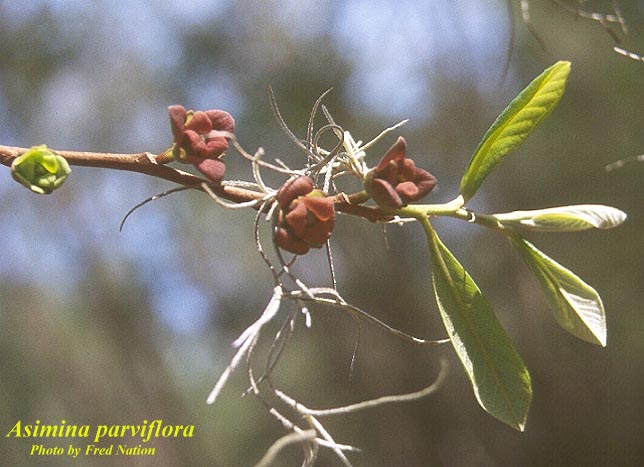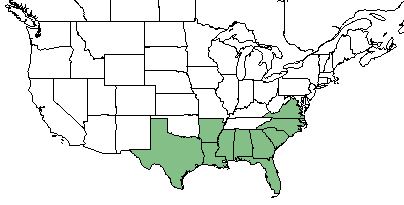Asimina parviflora
Common names: Smallflower pawpaw
| Asimina parviflora | |
|---|---|

| |
| Photo by the Atlas of Florida Plants Database | |
| Scientific classification | |
| Kingdom: | Plantae |
| Division: | Magnoliophyta - Flowering plants |
| Class: | Magnoliopsida - Dicots |
| Order: | Magnoliales |
| Family: | Annonaceae |
| Genus: | Asimina |
| Species: | A. parviflora |
| Binomial name | |
| Asimina parviflora (Michx.) Dunal | |

| |
| Natural range of Asimina parviflora from USDA NRCS Plants Database. | |
Contents
Taxonomic Notes
Synonyms: none
Varieties: none
Description
A. parviflora is a perennial shrub tree of hte Annonaceae family native to the southeastern United States. [1]
Distribution
A. parviflora is found in the southeastern United States, particularly in Florida, Georgia, South Carolina, North Carolina, Alabama, Mississippi, Louisiana, Arkansas, and Texas. [1]
Ecology
Habitat
A. parviflora is a deciduous shrub found in the Coastal Plain in the southeastern United States. [2]
This species has been found on sparse loamy sands, moist sands, floodplains, woodland slope, and bottomland hardwood forests. [3]
A. parviflora has been observed in dry-mesic hardwood hammock on a bluff above the Kissimmee River in Highland County Fl. This specimen is on the edge of it's southeastern range. .[4]
Phenology
The A. parviflora flowers are the smallest in the assimina genus with 4-6 maroon flowers per branch. The flowers are in bloom from February to May depending on the year. [2]
Seed dispersal
The A. parviflora is pollinated by insects including the greenbottle fly and nitidulid beetles.[2]
Seed bank and germination
The fruit from A. parviflora requires an average of 3-4 months to mature and the number of seeds germinated is low compared to the initial population developed. [2]
Use by animals
A variety of flies are the most common visitor to the A. parviflora but they have not been traced to pollination, which is largely a result from beetles and the greenbottle fly.[2]
Conservation and Management
Cultivation and restoration
Photo Gallery
References and notes
- ↑ 1.0 1.1 USDA Plant Database
- ↑ 2.0 2.1 2.2 2.3 2.4 [Norman, E. M., et al. (1992). "Reproductive Biology of Asimina parviflora (Annonaceae)." Bulletin of the Torrey Botanical Club 119(1): 1-6.]
- ↑ URL: http://herbarium.bio.fsu.edu. Last accessed: June 2018. Collectors: Loran C. Anderson, Robert K. Godfrey, William Platt, M. Darst, H. Light, P. Isom, L. Peed. States and counties: Florida (Wakulla, Jefferson, Franklin, Leon, Lafayette), Georgia (Thomas)
- ↑ Observation by Edwin Bridgesr in Highlands County, Fl. on the kissimmee River, February 8, 2016, posted to Florida Flora and Ecosystematics Facebook Group February 8, 2016.